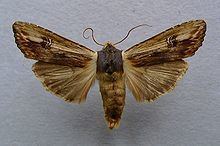Subphylum Hexapoda | Rank Species | |
 | ||
Similar Xylena exsoleta, Xanthia icteritia, Conistra ligula, Agrochola macilenta, Xanthia togata | ||
Xylena vetusta, the red sword-grass, is species of moth of the Noctuidae family. It is a Palearctic ecozone species found from north-western Africa through Europe and Asia up to central Siberia. In the north, it is found up to the Arctic Circle and Iceland.
Contents
Technical description and variation
The wingspan is 52–65 mm. Forewing long and narrow. Forewing pale greyish ochreous, the inner marginal half suffused with fuscous, or blackish brown, less strongly beyond middle; orbicular stigma obsolescent, marked by a brown dot or two, rarely outlined; reniform large, pale, with double brown outline, followed by a patch of brown scaling,joined by a black brown sagittate mark to the pale serrate subterminal line; a diffuse black blotch in the dark scaling represents the claviform stigma; lines very indistinct, indicated by dark vein spots; hindwing brownish fuscous. In the ab. albida Spul. a diffuse streak of white scales runs from base along the middle of wing extending to the space below the reniform and obliquely upwards to apex; in the females the dark markings are more mixed with blackish grey and in the males with brown; in ab. brunnea Tutt the ground colour is brighter ochreous, and the dark shading brown or black brown, the grey and white scaling being altogether absent.
Biology
Adults are on wing from August to June.
Larva bright green or olive brown; dorsal and subdorsal lines yellowish,the latter with 3 yellow tubercles above them on each segment; spiracular line yellow, black-edged above,with the spiracles red. The larvae feed on various plants, including Rumex hydrolapathum, Centaurea, Iris, Cyperaceae and Polygonum.
